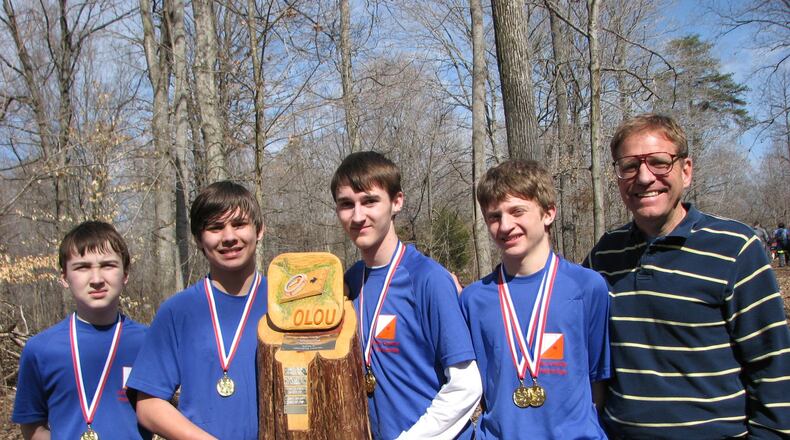Minium is actively involved and does something orienteering-related just about every weekend. He also heads up school programs during the week.
In addition to the local activity, Minium has traveled nationally and internationally to orienteering events.
We talked to Minium to find out more about his enthusiasm for orienteering. He also gave us details on two upcoming orienteering events in the region.
Two local Orienteering events are planned for New Year’s Eve and New Year’s Day. The New Year’s Day outing will be held at Camp Timberhill on Jan. 1 from 11 a.m. to 1 p.m.
For those more experienced, there will be a New Year's Eve night course at Camp Timberhill, starting at 8 p.m. Pre-registration by email is encouraged. For more information, go online to www.OCIN.org and the special events page at www.yourmetroparks.net. Guests can also email mikeminium@aol.com.
Q: Tell us about yourself? When did you get involved in Orienteering?
A: I grew up on the west side of Cincinnati, in the Western Hills area. I went to college at Miami University and to graduate school in Indiana. After a few years working in various places, I ended up back in Oxford, getting a teaching certificate. I started Orienteering in 1985, shortly after I got out of college. I have always been very interested in maps, I like the outdoors, and getting out into the woods. I'm also an amateur birdwatcher, so there were things I really liked about the outdoors, studying maps and finding my own way. I had read and heard that there was this sport called Orienteering. I found out about Orienteering Cincinnati, which was newly formed at the time. It was started a few years earlier. I fell in love with Orienteering, and within a year or so, I set up courses for a competition at the club, and I've been doing it ever since. I'm involved in a lot of Orienteering programs for school groups, where I will go to a school, and do a day or two of classroom training. Then, we will do a field experience either on the school grounds, or at one of the parks. I coach the Orienteering team at Union County High School and Union County Middle School in Liberty, Ind. I have about 15 students involved there. Our team is currently the National High School Champions. We won the National Championship in Texas last spring, and we are hoping to attend the competition again this spring in Massachusetts. They have a great program, and I work with a tremendous group of students.
Q: How long have you been coordinating the New Year’s Orienteering events?
A: I've been coordinating the New Year's events every year since we started doing it. We started in the 1990's. I'm not sure what year, but it's been at least 20 years…We've been at Camp Timberhill for the last eight years. I'm also coordinator of a national event that Orienteering Cincinnati hosts every year, the Flying Pig Orienteering event. It's actually two years older than the Flying Pig Marathon. This coming spring will be the 22nd year for that event. It will be held on April 6-8, 2018.
Q: How many events do you hold, annually?
A: Orienteering Cincinnati is a regional Orienteering club. There's another group in the Dayton area called Miami Valley Orienteering Club. Orienteering Cincinnati puts on 30 to 35 events per year throughout the region. The Miami Valley Orienteering Club holds about 10 more events per year.
Q: What’s involved in setting up an Orienteering course?
A: The most complex and technical part of Orienteering is producing the map that we use. The maps are very detailed. They take a lot of effort to prepare a map, initially. We start with available government information from aerial photos. … There's also new data called LIDAR (Light Detection and Ranging), which is like aerial photography, but it's done from an airplane with a laser. It's very precise elevation data from both the ground and the vegetation. We combine that information to make maps that are more detailed than what's generally available to the public.
Q: What do you enjoy about being involved in Orienteering?
A: I enjoy working with the kids and school groups, seeing kids, maybe from inner-city areas that may not have had much experience in the woods. They get off the pavement, and they are afraid of their own shadow at first. I have an opportunity to see them develop an appreciation for nature, begin to figure out the map and develop some self-confidence in finding their own way. Then, they realize that they are not going to get eaten by whatever wildlife or boogie man that is out there, and they are going to accomplish this on their own. The greatest reward for me is seeing kids develop confidence and a level of skill at the sport.
Q: Have you received any awards or accolades for Orienteering?
A: I have been honored with a few United States Championship Awards. I've won in my age group in the "United States Night Orienteering Championships" several times. I've received the "Silva Award," which is Orienteering USA's highest recognition for a volunteer. That award is given annually to one person in recognition of their volunteer service to the national organization, and to local and regional Orienteering efforts. I don't like to brag, but I'm proud of that one.
Contact this contributing writer at gmwriteon@aol.com.
RELATED
Preview: New Year's Day Orienteering event in Hamilton, page B1
About the Author
